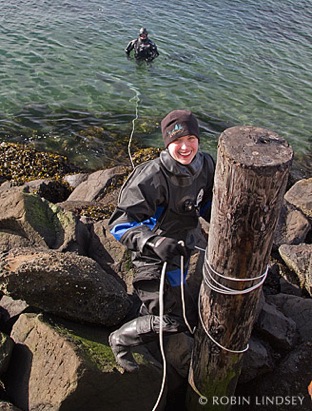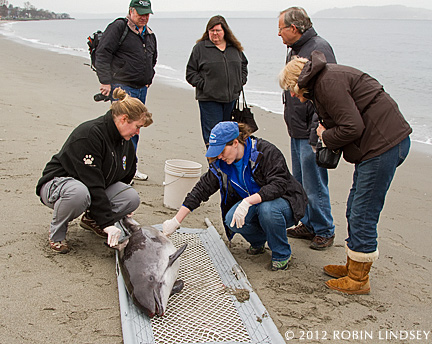(necropsy results at end of story) Yesterday afternoon at approximately 3pm, the Seal Sittters hotline received a call from NMFS (NOAA) regarding a report of a “dolphin” in distress off West Seattle. Our responder arrived within minutes, but the animal had just died below the sea wall. A witness said the animal, in reality a harbor porpoise, was swimming in circles just offshore and then died. As the tide began to recede, our lead investigator scaled a rope ladder over the wall in efforts to retrieve the porpoise before the possibility of vanishing with the surging tides. The water, however, was too deep without a wetsuit and snorkel. Calls were quickly made to WDFW’s Marine Mammal Investigations’ biologist Dyanna Lambourn and a plan was put into motion to attempt to secure the animal until a necropsy could be performed.

Since the animal was in water too deep, volunteer David took off for the diving coves in search of divers who might be able to help us out. A team of UW Fisheries divers happened to be at Don Armeni boat launch after returning from a dive. Mike Caputo and Erin Morgan graciously agreed to help out. Mike and Erin scaled the wall and he swam out (photo above) to loop a length of rope around the rear fluke and tow to a nearby piling. Erin secured the rope to the piling (left) until the network could figure out our next move.
While the team from
Cascadia Research (primary response team for cetaceans in South Puget Sound and the outer coast) and
WDFW-MMI weighed the options with impending tide levels, it was determined the animal needed to be moved to an area with easier access than the steep rocks below the sea wall. Our investigator scaled the wall and towed the porpoise in the surf approximately 1/3 mile down to the sandy beach at Alki. Three volunteers assisted her in getting the estimated 150 lb. porpoise high up onto the beach, secured behind a large log overnight. Volunteers Christine and Raiana measured the porpoise at 5’8” while our responders documented the general condition with photographs. There were no obvious wounds evident in our preliminary examination of the porpoise.
The Cascadia/WDFW-MMI team will pick up the animal today and perform a necropsy to determine cause of death. Please check back for additional photos and an update on the necropsy results.
To learn about harbor porpoise,
click here.
UPDATE: 3/18 afternoonEarly this morning,
WDFW-MMI marine mammal biologist Dyanna Lambourn and Jessie Huggins, biologist and stranding coordinator for
Cascadia Research, arrived to do a preliminary exam of the animal prior to removing the body for necropsy. The harbor porpoise was an adult female and on the thin side. As the team conducted their exam, Patrick Sand and Tracy Record (left background) of the
West Seattle Blog and SS volunteers David and Eilene Hutchinson observed and learned about the biology of harbor porpoise who have become more prevalent in Puget Sound waters. The animal was carried from the beach and driven to WDFW’s lab for a full necropsy. We will post the results on Blubberblog as soon as they are revealed. Thanks to all involved in this well-coordinated and challenging effort!
NECROPSY RESULTS UPDATE: 3/18 10:31 pm
Just in - The preliminary results of the necropsy reveal that the 3-5 year old female harbor porpoise suffered from a severe lung infection, with approximately 90% of each lung affected with pneumonia and markedly enlarged lymph nodes in the chest. The infection appeared to be systemic - not only causing damage to the chest , but had spread to the abdomen as well. Tissue samples will be sent to multiple laboratories to determine cause of the infection (fungal, bacterial, viral, parasitic or a combination of organisms). Final results can take a couple of months.
Tags: harbor porpoise, necropsy










